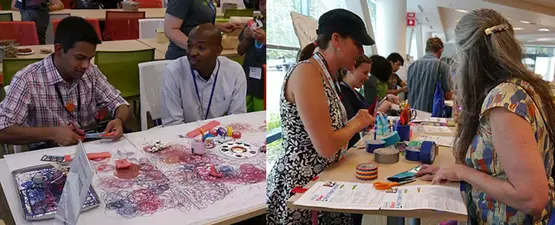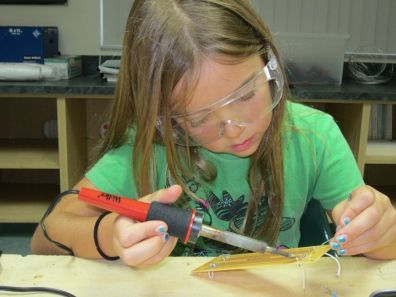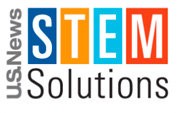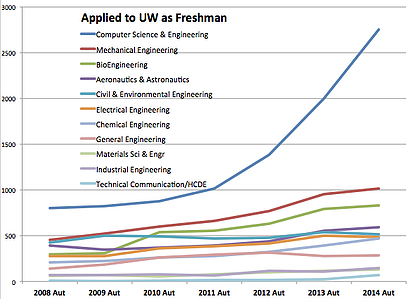RobotLAB Blog
Everything You Need To Know About Robotics in Businesses
california schools embrace blended classrooms

Oakland CA schools have a problem trying to teach their academically diverse student body. Kilian Betlach, the principal of Oakland’s Elmhurst Community Prep says that while one third of Elmhurst’s kids are at grade level in reading and math, the remaining two thirds are from one to four years behind. No doubt Principal Betlach’s school shares the same problem with many inner-city, high-poverty middle schools.
The question of how best to address this problem is complicated by lack of staff and lack of funds -- another common problem with inner-city schools. With too few teachers, how can they keep the slower learners from falling farther behind without denying faster learners the time they deserve and thereby cheating them all of a decent education? Unfortunately the answer to this problem is not to be found in the old factory model of education most of us grew up with.
- 0 Comments
- Jul 30, 2014 12:00:00 PM
- Posted by Mike Nardine
- Topics: Education Politics, 21st Century Classroom
subvert the K-12 classroom -- Makerbot can help

Students and teachers in the United States unite, you have nothing to lose but your boring textbooks (apologies to Karl Marx)! A revolution is in the Making -- pun intended! We must overthrow the dull, unimaginative educational processes that have sent so many of us running from the STEM subjects (Science, Technology, Engineering and Math). It won’t be easy; the present system has centuries of tradition and billions of dollars behind it. A direct onslaught won’t win this revolution ... we’re going to have to become subversives! Or, as Dale Doughterty, founder of Make Magazine and Co-Founder of Maker Faire put it last month at the 9th Annual Maker Faire in San Mateo, CA.,“I could probably make it easier for all of us if I said that [Making] aligns perfectly with all the educational standards and all the mainstream thought in education … But I think it’s actually subversive ... subversive because it’s causing change, and innovation … It’s a desire to change the way things are, and making in schools needs to be subversive if we’re going to invite kids to actually do things that are meaningful to them.”
- 0 Comments
- Jun 27, 2014 12:00:00 PM
- Posted by Charles Nimrad
- Topics: Education Politics, 21st Century Classroom
Chevron invests in bringing more girls into STEM

Some argue against the intrusion of big business into education. Critics left and right have what they consider good reason to fear the beginning of a “slippery slope” leading us toward disaster. President Obama seems to have no such fear as in his February 12, 2013 State of the Union Speech he asked for the creation of “manufacturing hubs, where businesses will partner with the Department of Defense and Energy to turn regions left behind by globalization into global centers of high-tech jobs.”
Energy giant Chevron is forging ahead with plans to assist educators of students who will become the tech sector's skilled STEM-educated employees. In the next three years Chevron intends to invest more than 30 million dollars in STEM learning in this country. Blair Blackwell, Chevron’s manager of education and corporate programs tries to alleviate the fear of big business intrusion by admitting that “We recognize we’re not education experts. We have to partner with the education experts, with officials on the ground.”
- 0 Comments
- Jun 19, 2014 12:00:00 PM
- Posted by Mike Nardine
- Topics: STEM, National News, Education, Education Politics, 21st Century Classroom
The US needs more programs to expose students to computer science
The long and the short of it is simply this: the Bureau of Labor Statistics predicts that in the next six years the demand for computer programmers will exceed the supply by at least one million. That’s one million jobs that will likely go to individuals from outside the US. These will be some of the best paying jobs around and the segment of our society that will lose the most will be women, students from rural areas, and students of color.
Why is that? Colleges across the country are flooded with requests for an education in computer science in numbers that would meet that and any future demand. Simple answer: there are not enough classes, teachers or equipment to meet that enormous demand. And there's not much chance that will change anytime soon. Colleges and universities have simply been caught flat footed after cutting back in their computer science departments.
- 0 Comments
- Jun 16, 2014 6:56:26 PM
- Posted by Mike Nardine
- Topics: National News, Education, Education Politics, Computer Science
court ruling gives teachers even more incentive to challenge students
Teaching has always been a tough, thankless job. Back before the teachers’ unions managed to give members of the profession some degree of security it was a job that allowed hiring and firing at the whim of the educational powers-that-be. In recent years there have been complaints that teachers’ unions have taken the system too far the other way and that it is now impossible to get rid of bad teachers, thereby making it impossible for students--particularly minority students--to get a good education. That was the argument made by the nine students before Los Angeles Superior Court Judge Rolf Treu in Vergara vs State of California. Judge Treu saw it their way. Plaintiff Julia Macias, entering high school this year, said Judge Treu’s decision proved “students have a voice and can demand change when we stand together.”
This is one of those rare times when we can say with no attempt at flippancy, that we feel strongly about both sides of this debate. How can we not sympathize with students who feel their futures have been jeopardized by poor teachers and entrenched bureaucracy? And how can we ignore the feelings of those good teachers -- certainly the vast majority -- who believe their careers and their family’s future is now in jeopardy from over-zealous politicians, looking for quick fixes to complex funding problems? We can’t…
- 0 Comments
- Jun 13, 2014 12:30:00 PM
- Posted by Brendan Barnard
- Topics: Local News, National News, Education Politics
STEM + (EdTech x Hands-On Learning) = An Equation for Engaged Students

A recent yahoo story disclosed a growing chorus of parental complaints about the difficulty of the new Common Core standards for math. Having trouble with the math themselves while trying to assist their children with homework, parents complain that the standards are simply too difficult for their children. Adding, subtracting, multiplying and dividing they say is now as difficult as calculus. “Satan’s handiwork,” cries one rattled parent.
- 0 Comments
- May 22, 2014 4:36:14 PM
- Posted by Elad Inbar
- Topics: EdTech, National News, Education Politics, 21st Century Classroom
Math curriculum makeover

Math teacher Dan Meyer is at it again! No longer content to just insist that teaching math has got to become entertaining if today’s kids are going to compete with kids from around the world, he’s now on record saying math teaching should get out of the textbook and go multimedia, audio, video -- the whole deal.
He’s got a point: kids live in a multimedia environment, maybe they should be learning in one as well. And as he points out, the multimedia learning environment needn't set the school or the teachers budget back by that much: “...this is an amazing time to be a math teacher right now ...because we have the tools to create this high-quality curriculum.... It's ubiquitous and fairly cheap, and the tools to distribute it freely under open licenses has also never been cheaper or more ubiquitous.”
- 0 Comments
- May 20, 2014 12:00:00 PM
- Posted by Charles Nimrad
- Topics: Math, EdTech, Education, Education Politics, 21st Century Classroom, Student Engagement
MakerBot and RobotsLAB want to put a 3D printer in every US public school
We all need to think creatively about giving our young people the tools to be 'the makers of things, and not just the consumers of things.
The above quote is by Tom Kalil, Deputy Director for Technology and Innovation within the White House Office of Science and Technology Policy, following up on a statement by President Obama in his 2013 State of The Union speech where he said "3D printing has the potential to revolutionize the way we make almost everything. The next industrial revolution in manufacturing will happen in America."
- 0 Comments
- May 19, 2014 1:59:55 PM
- Posted by Elad Inbar
- Topics: EdTech, National News, Education Politics, 21st Century Classroom
Improving gender and ethnic diversity in STEM jobs
 As everyone in the field is well aware, women and ethnic minorities are not sufficiently represented in STEM careers and in learning programs nationwide. Increasing their participation in a field that is fast becoming an important job provider in this country was the subject of a recent “Creating a Sustainable Commitment to STEM” session at U.S. News & World Report's STEM Solutions Conference in Washington, D.C.
As everyone in the field is well aware, women and ethnic minorities are not sufficiently represented in STEM careers and in learning programs nationwide. Increasing their participation in a field that is fast becoming an important job provider in this country was the subject of a recent “Creating a Sustainable Commitment to STEM” session at U.S. News & World Report's STEM Solutions Conference in Washington, D.C.
- 0 Comments
- May 13, 2014 4:00:00 PM
- Posted by Mike Nardine
- Topics: EdTech, STEM, National News, Education, Education Politics, Student Engagement
Gates Foundation report - Teachers Know Best: What Educators Want from Digital Instructional Tools
 Instead of simply leaving it to guesswork, the Bill and Melinda Gates Foundation decided to come right out and ask the question “What do teachers want?” The foundation asked the question because “in our work with schools over the last few years, we have heard a common theme: Teachers are trying hard to challenge and engage their students, but they don’t have sufficient choices for effective digital instructional tools that truly meet their needs.”
Instead of simply leaving it to guesswork, the Bill and Melinda Gates Foundation decided to come right out and ask the question “What do teachers want?” The foundation asked the question because “in our work with schools over the last few years, we have heard a common theme: Teachers are trying hard to challenge and engage their students, but they don’t have sufficient choices for effective digital instructional tools that truly meet their needs.”
- 0 Comments
- May 7, 2014 8:00:00 PM
- Posted by Elad Inbar
- Topics: EdTech, Education Politics, 21st Century Classroom, Student Engagement
Relevant Posts
- Augmented Reality: A Tool for Teaching Students Robot Programming
- Fostering Innovation Through Youth Education in STEM and EdTech
- How Parents Can Foster STEM Learning Beyond the Classroom
- How Robotics Cultivates a Deep Understanding of Mathematics in Students
- RobotLAB Receives EDTech Chronicle 2023 ‘BESTIE’ Award for Landmark Partnership with American Samoa Dept. of Education.
Subscribe to Email Updates
-
I Want To Learn MoreADDITIONAL INFORMATION


